Movement is essential for our back and general bodily health. Yet when we sit all day, we are often static. Safety Management visits a unique ergonomic furniture shop to find out if active sitting could prevent pain.
Features
Made to move
Most jobs nowadays involve a fair amount of sitting. Whether you’re an MP, or a marketing manager, an accountant or in air traffic control, it’s certain that you’ll be sitting at a desk for some, if not all, of your working day. Yet too much sitting is bad for our bodies, which were designed to move.
So, what’s the solution? According to Sianna Lunn, store manager and senior sales specialist at Back in Action, an ergonomic office chair and home furniture shop, there’s a way to move our joints and muscles without leaving our chairs and it’s called active sitting: “It’s innate for us to fidget and want to move around,” she says. “As hunter gatherers we were on our feet and had to move around to survive, and now, we sit in chairs and that brings the money in and that’s how we survive."
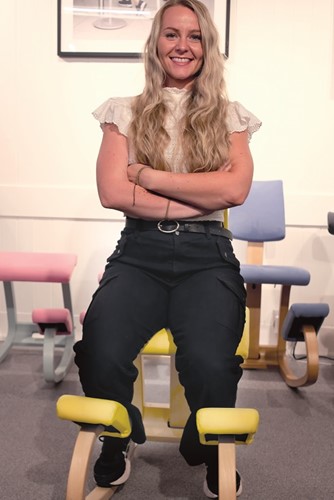 Sianna Lunn on a kneeling chair, one of many active chairs stocked at Back in Action. Photograph: Matthew Holder
Sianna Lunn on a kneeling chair, one of many active chairs stocked at Back in Action. Photograph: Matthew Holder
Sianna believes active sitting can prevent ill health issues associated with static and prolonged sitting. “I think we would see far less people needing time off work because of back pain, and we would see far more available money in the NHS because we’re not having to medicate, do MRI scans, if we all just knew and did more about active sitting.”
What is active sitting?
Active sitting consists of adapted or ergonomic chairs that allow the body to stay dynamic while seated.
At Back in Action, whose Amersham branch in Buckinghamshire I visit, it is stocked full of them. They range from eye-catching lounge chairs in bright colours, to beautiful kneeling chairs and more recognisably simple office chairs. The idea is everyone is catered for in every conceivable sitting-based activity at home or the office, but with movement built into the furniture’s design.
The chairs work by supporting the body to do what Sianna calls ‘micro movements’ that increase blood flow to muscles which support the joints: “Your best position is your next position,” she says quoting the Norwegian designer Peter Opsvik on whose designs many of the ranges here are based. “There’s no one fixed posture that’s going to save your back over a long period of the day. We need to keep moving to reduce the pressure we would otherwise be building.”
The chair I try (Creed) allows forward and backward momentum, gently working the core. I can be upright and balanced or enjoy lying right back for a truly delicious recline. During my conversation with Sianna, I begin trying out these movements. “It’s a subconscious thing,” she points out, “our bodies crave movement – you’re doing it now – you get into conversation you’ll move your arms, you’ll be typing, then spin in your chair to chat to your colleagues… and it’s those tiny little micro movements which help to keep you free and energised and reduce static pressure build.”
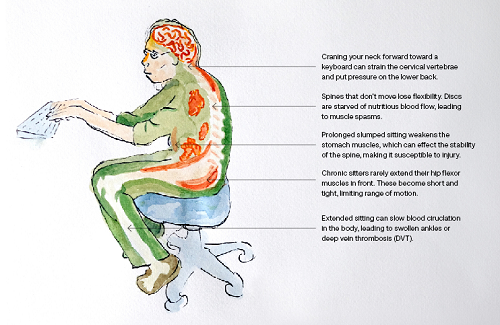
 An illustration showing the damage that poor posture and prolonged sitting can do to the body. Illustration: Matthew Holder
An illustration showing the damage that poor posture and prolonged sitting can do to the body. Illustration: Matthew Holder
Sitting and health
Sitting isn’t exactly up there with free diving, or tree surgery in terms of occupational risk. Yet, look closer and our bodies are not thanking us for those eight-hour stretches many regularly do at the desk. Our bodies are made up of muscles, joints, tendons, nerves, cartilage and bones – known as the musculoskeletal system.
Impairments to this system are known as musculoskeletal disorders and they are the greatest ill health issue behind mental health, accounting for 27 per cent of all work-related ill health in 2022 according to HSE. 1.35 million people in the UK are out of work due to musculoskeletal pain, according to the ONS’s latest bulletin, more than half of the total off sick.
Scientists say that sitting is at least partly to blame. According to EU-OSHA’s 2021 paper, Prolonged static sitting at work: health effects and good practice, “our bodies need movement, and avoiding static postures is part of making work sustainable.” It said that just two hours at a stretch is defined as enough to be ‘prolonged sitting’, which carries health risks including low back pain and neck and shoulder complaints.
The pandemic has only made these issues worse. Millions of workers made home their place of work and many weren’t prepared. Kitchen tables, wooden chairs, even sofas and beds were used to work on, all compounded by soaring stress levels. We know this led to a spate of new aches and pains. Neck pains shot up 58 per cent and back pain by 55 per cent, according to an Institute of Employment Studies survey in 2020.
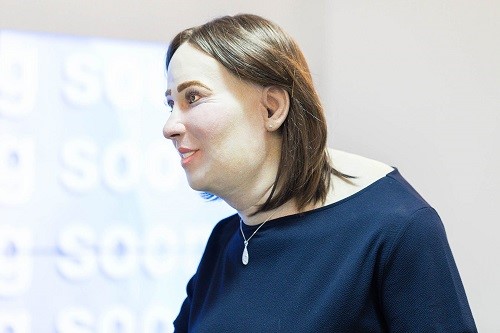
 The hunched figure of Emma was created to show what our bodies could look like in 20 years if we continue working with poor posture. Photograph: Fellowes
The hunched figure of Emma was created to show what our bodies could look like in 20 years if we continue working with poor posture. Photograph: Fellowes
But we don’t know the full impact – a review published in March by Ivan Gomez et al, concluded that pain was ‘significantly higher’ for workers compared with pre-pandemic times. But added that: “The literature on the effects of the Covid-19 pandemic work from home setup on musculoskeletal functions has been fragmented or, at best, yet to be reviewed.”
Spongey discs and heavy heads
So, what’s going on in the body when we sit still for long periods? Like all joints, the spine requires a constant supply of oxygenated blood. When we sit still it reduces that nutritious blood flow. “Healthy discs should work like a wet sponge being squeezed and resoaked repeatedly," says Sianna.
“Movement is essential: when you move, it draws in water and nutrients while also ridding it of waste products. If you’re too rigid, you end up with a ‘toxic soup’ that sits in the disc creating a hostile environment. This stagnation will lead to flat, dehydrated discs which are no longer great at load bearing, which forces the weight onto the surrounding facet joints, eventually causing inflammation and pain.
This is likely to lead to muscle spasms and in the worst cases, limited mobility or disc herniation (slipped disc),” she explains.
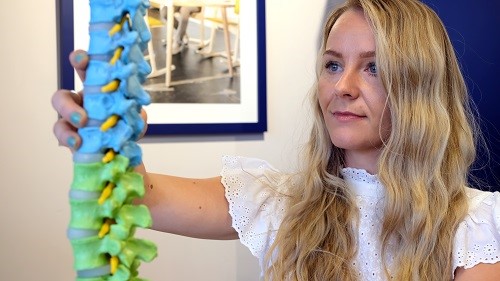
 “Healthy discs should work like a wet sponge being squeezed and resoaked repeatedly," says Sianna. “Movement is essential."
“Healthy discs should work like a wet sponge being squeezed and resoaked repeatedly," says Sianna. “Movement is essential."
Poor posture is also to blame, says Jo Blood who runs Posture People, a family-run business which gives advice on workstation set up and supplies ergonomic equipment. Craning forward, for example, isn’t just bad for the neck but also the lower back: “The head’s heavy, it weighs about five pounds, and as it comes forward, your lower back works harder and harder so it puts all of that pressure onto that lower back section.”
Of course, musculoskeletal issues aren’t the only unfortunate byproduct of prolonged sitting. Studies have linked excessive sitting to increased risk of diabetes, heart disease, mental health issues and obesity. A study in Scotland found working-aged people sit more than pensioners! Clearly, we have a problem.
Time to rethink the advice?
HSE advises desk-based workers to get up for five to ten minutes every hour. According to its Working with display screen equipment guide, “breaking up long spells of DSE work helps prevent fatigue, eye strain, upper limb problems and backache.”
But, really, is this practical? When we’re facing a flood of emails or immersed in a project, it’s hard to flex so much time just to flex our muscles. According to a recent TUC report, workers are increasingly overwhelmed – 1 in 2 said they feel work is getting more intense and demanding. Fitting in a ten-minute stretch every hour is admirable but looks unrealistic in this context.
Sianna also believes that the hourly guideline isn’t accurate for our bodies’ needs. “Our bodies probably have a limit of 15–20 minutes in one position before we’re going to start picking up stresses and strains.”

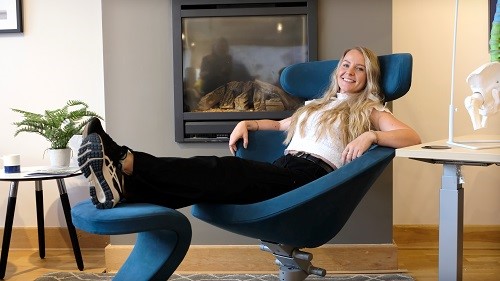 Our cumulative sitting time is made up of work-related and leisure sitting. Here Sianna relaxes in a lounge chair which is also designed to support gentle movement while relaxing. Photograph: Matthew Holder
Our cumulative sitting time is made up of work-related and leisure sitting. Here Sianna relaxes in a lounge chair which is also designed to support gentle movement while relaxing. Photograph: Matthew Holder
She says we need to get away from the idea of the perfect posture, not because it’s wrong, but because people mistake ‘posture’ for ‘poise’, something you can hold for hours: “I think people have this idea that posture is a fixed thing – and they are frightened [they might] deviate away into what they think is a ‘bad’ posture.
"But at Back in Action and in our industry where we look at active sitting, we think more about balance and poise. A series of different positions all of which are within the spectrum of being ‘safe zones’ for you to work in. You can hold a ‘bad’ position for a short time without it creating long term damage but holding a ‘good’ position for an extended period can still lead to problems – the key is movement.”
Why don’t we hear more about active sitting?
People who find themselves at Back in Action are sadly often already in chronic pain. “People come in here broken,” says Sianna. “They’ve probably been to physios, doctors, tried every medication, every stretch going and it’s not until they’re feeling a bit more hopeless with the different avenues they can go down before they do their own research and end up in a place like this.” These aren’t people who have injured themselves in a fall, or an awkward stretch, but through “long term bad postural habits, typically through poor sitting or static behaviours”.
They are rarely referred here, or the shop’s other branches in Bristol, London and Marlow, by their employer. So why isn’t active sitting more known about as a workplace solution? Partly, HSE hasn’t been able to draw a neat line between work sitting and health issues, because we also sit for leisure, such as to read and watch TV. In its 2019 review Sedentary Work and Health, HSE concluded that more research needs to be done to isolate work sitting behaviours and impacts. For example, by using wearable technology to obtain valid measures of exposure.
But others say this isn’t good enough. The Display Screen Equipment (DSE) Regulations haven’t been updated for 30 years since they were first drawn up in 1992. “They don’t talk about laptops, or smartphones, they only offer very basic rules and guidelines. I don’t think employers are even aware of some of their responsibilities,” says Jo Blood.
Some employers Jo speaks to don’t even know what a workstation assessment is: “It’s frustrating. A lot of people are now doing office-based jobs and therefore there should be tighter restrictions around caring for your staff. We spend far too long sitting at a desk to do it badly, yet no one ever teaches us to sit at a desk.”
The cost factor
Yet there are drawbacks to active sitting. Chairs at Back in Action and other retailers range from £300 to £2,500 and some employers might struggle to afford that. Are there cheaper solutions? Jo suggests setting an egg timer to go off in another room to act as a prompt to get up. She adds home workers can do ‘false commutes’ – walking around the block first thing – or try inexpensive devices like a Sissel ‘sit fit’ cushion. The air-filled disc can be placed on a chair or used for exercising feet and legs while sitting too.
It’s also important to get proper advice and try out different options. “People buy chairs from us online all the time,” says Jo, “but we’re knowledgeable about what we do – and if people tell us the problems they’re having and what their desk set up is… we can normally give good advice as to what’s going to work for them. Whereas if you just order something from Amazon the chances are it’s going to be fairly poorly made and not going to solve your problems.”
Healthy ageing
But the real clincher for active working is healthy ageing. Muscle mass decreases by around 3–8 per cent per decade after the age of 30 and this rate of decline is even higher after the age of 60. Sports scientists and doctors advise us to build muscle strength, so we can age better – strong hips for example help us prevent falls in later life.
Yet sitting ordinarily makes our hip and other key muscles weaker, because we aren’t using them. Studies have also claimed that even for those who exercise, sitting for long bouts increases the risk of getting a disease or condition that will eventually prove deadly (see Annals of Internal Medicine, January 2015).
But Jo worries that we just don’t know what problems we’re shoring up for the future: “The generation that saw large scale computer usage hasn’t reached old age yet, we’re probably about 10 years off that,” she says. Our parents would have walked to the printer, phone or fax machine. Today, many of us don’t even walk to the Tube anymore. “Everything tends to be even closer for home workers,” agrees Jo. “You’re not walking so far to the kitchen or water cooler, and you don’t have the distraction of office friends so you tend not to walk around as much.”
Educating for an active workforce
Both Jo and Sianna would like to see active sitting recognised as a preventative solution by employers. Sianna believes the principles of movement should even be taught in schools: “You hear of children being told to ‘sit still’ and so we associate early on movement with being naughty or doing something wrong. It limits our range of movement in later years.”
So, is active sitting the future?
A bit like Goldilocks, it’s about finding what works for you. “Active sitting isn’t for everybody,” says Jo. “Some people find it’s too much movement for them, some people absolutely adore it.” Ideally, workers would have recourse to both a stand-up desk and an active chair, the “really gold standard” says Jo.
For those employers and employees who don’t have the wallets for such well-equipped workstations, everyone can aim to move more: “Movement is the thing that you need,” concludes Jo. “It doesn’t matter which form it comes in, whether a chair or a desk, but you have to build movement into your day to try and counteract the sedentary sitting down. That’s the really important thing.”
For more information visit: backinaction.co.uk or posturepeople.co.uk
See also HSE Working with display screen equipment
FEATURES

Underpinning safety training with neuroscience for long lasting impact
By SSE Active Training Team (ATT) on 30 November 2025
A behavioural safety training programme developed by Active Training Team for energy provider SSE has been carefully designed with neuroscientific principles in mind – resulting in a prestigious industry award for Best Training Initiative in 2024.

Why a painted line will never be enough
By UK Material Handling Association (UKMHA) on 20 November 2025
Businesses that operate material handling equipment like forklifts are being urged to submit accident and near miss details to a new confidential reporting portal so the industry can identify what needs to be done to improve safety standards.

Why workplace transport training is changing in 2026 and what it means for employers
By AITT on 05 January 2026
New workplace transport training categories due in January mean it is essential to ensure operators of material handling equipment have the necessary training for the exact type of machine they use, and accredited training providers are an ideal source of advice and conversion training.



